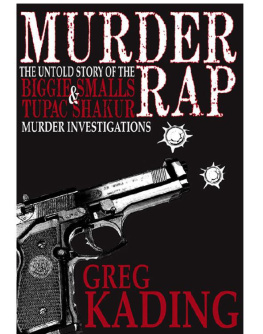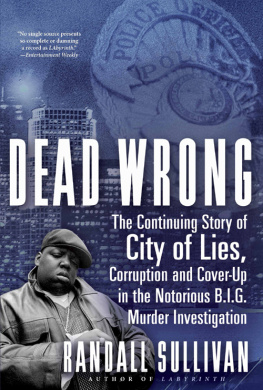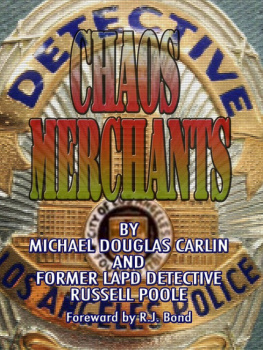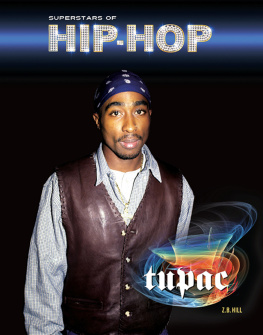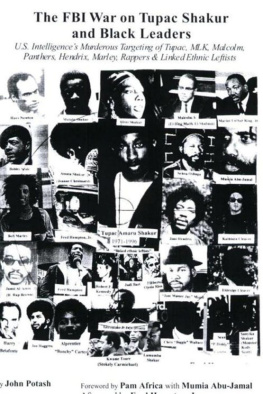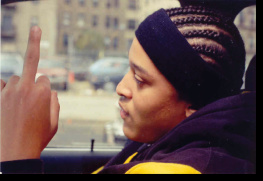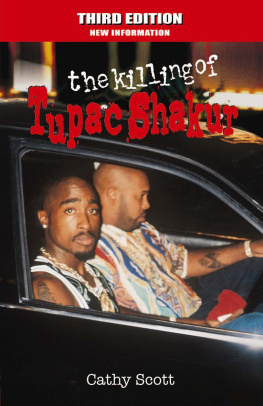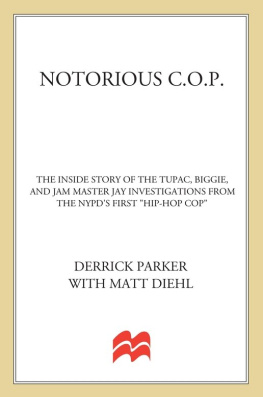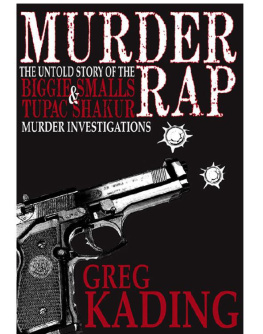

Copyright 2011 by Greg Kading
All rights reserved. No part of this book may be reproduced in any form or by any electronic or mechanical means, including information storage and retrieval systems, without permission in writing from the publisher, except by a reviewer, who may quote brief passages in a review. Scanning, uploading, and electronic distribution of this book or the facilitation of such without the permission of the publisher is prohibited. Please purchase only authorized electronic versions, and do not participate in or encourage electronic piracy of copyrighted materials. Your support of the authors rights is appreciated.
Some names have been changed to protect the privacy of certain individuals connected to this story
Published in the United States by One-Time Publishing LLC
Library of Congress Cataloging-in-Publication Data
eBook conversion by 1106 Design, LLC
Kading, Greg.
Murder Rap: The Untold Story of the Biggie Smalls and Tupac Shakur Murder Investigations/Greg Kading.
ISBN for Kindle/Mobipocket: 978-0-9839554-4-3
www.MurderRap.com
First Edition October 2011
To Afeni Shakur and Voletta Wallace
Whenever human justice fails, rest assured that Gods prevails
CONTENTS

PART
ONE

CHAPTER
Hit Em Up

T HE MIRACLE MILE is one of the most famous and familiar addresses in Los Angeles. An imposing strip of high rises, museums and landmark buildings, it runs down Wilshire Boulevard straight from the heart of Beverly Hills. Along the broad six-lane thoroughfare, the cream of L.A. society movie stars and sports figures, politicians and tycoons come to see and be seen, in an endless round of gallery openings, charity events and nightclub photo ops.
The Petersen Automotive Museum is a late but prestigious addition to the Miracle Mile, and one of the citys premier venues for high profile partying. Located on the southeast corner of Wilshire Boulevard and Fairfax Avenue, its parking structure running another block down Fairfax, the Petersens stylized tail fin facade faces directly across the street from the Art Deco-style May Company department store, the gold-plated new addition to the Los Angeles County Museum of Art. Together the two guard the western gateway of the renowned boulevard, and its hard to imagine a more prime piece of real estate than that occupied by the four-story, 300,000-square-foot showcase of automotive history.
The museum, opened in 1994, features five rotating galleries spotlighting a priceless array of vintage cars, a state-of-the-art showcase for auto design and technology, and a glass-walled penthouse conference center. But it is the second floor of the museum, the Grand Salon, that makes the Petersen ideally suited to the kind of celebrity-studded events for which the Miracle Mile is best known. The polished onyx floor, auto-inspired dcor, and displays of one-of-a-kind luxury and concept cars are the perfect setting for galas, receptions, and black-tie functions. From almost the moment it opened its doors, the Petersen was the setting of choice for L.A.s most prestigious social occasions.
The evening of March 9, 1997, was one such occasion. The night before, at the downtown Shrine Auditorium, the Eleventh Annual Soul Train Music Awards had spotlighted a new generation of black music superstars. Although the shows hosts included the sixties R&B great Gladys Knight, and the program included a Heritage Award to the legendary soul singer Curtis Mayfield, it was clear to everyone in the house that the torch was being passed.
And among the more significant new torch bearers was a 6'3", 360-pound Brooklyn-born rapper named Christopher George Latore Wallace, aka Biggie Smalls (after a character in the 1975 film Lets Do It Again ), aka Frank White (the hero of the 1990 film King of New York ), aka the Notorious B.I.G., or aka, simply, Biggie.
Although he had not been nominated in any category, there was no doubt that Biggie Smalls represented the future of music. His second album, a double-disc set titled Life After Death, was two weeks away from its highly anticipated release and already the intentionally leaked track Hypnotize was a huge radio hit. It was easy to hear why. With a hook based on a sample from the Herb Alpert instrumental Rise, the song was a perfect showcase for Biggies trademark loose and easy flow and his compelling, autobiographical rhymes. Within days of its official release Hypnotize would rocket to number one.
Biggie had been invited to the awards to present the trophy for Best Female Vocalist. Sharing the podium with him that night was Sean Puffy Combs, riding high with his own chart-topping single, and recording debut, Cant Nobody Hold Me Down. Combs, a multitasking musical entrepreneur, was a major player on the exploding rap scene. With his own string of aliases, including Puff Daddy and P. Diddy, Combs was most commonly known simply as Puff for his childhood habit of huffing and puffing when he got angry. The Harlem native, son of a murdered drug dealer, Combs began his meteoritic ascent as a concert promoter before breaking through with his own label, Bad Boy Records, in 1993. The companys first signing: Biggie Smalls.
Combs had since gone on to oversee every aspect of Biggies career, co-writing and co-producing Hypnotize along with the subsequent Life After Death hits, Skys The Limit and Mo Money Mo Problems, tracks that owed much of their success to Combs flair for polished production. Combs would, in fact, go on to almost singlehandedly bring rap music into the mainstream, helping create the smooth, listener-friendly genre of commercial hip-hop, the most successful form of popular music since rock and roll.
But in the Shrine Auditorium that night it was hard to imagine that the gangster lifestyle celebrated in the music of Biggie Smalls could, by any stretch, be considered in conventional pop terms. What Biggie and Puff were formulating in the studio and on stage would redefine what constituted socially acceptable entertainment. It was raw, profane, and unapologetically in-your-face.
Its polarizing effect was underlined by the fact that not everyone in the audience that night greeted Biggie and Puff with ecstatic cheers. As they stood to present the award to Toni Braxton, scattered jeers and shouts of West Side! could be heard ringing out under the halls high ceilings.
What up, Cali? Biggie murmured, leaning into the microphone. But the booing only got louder as the tension rippled across the auditorium. West Coast gang signs were flashed in the glare of the TV lights. It was obvious that the Notorious B.I.G. and his mentor, Puff Daddy, were in hostile territory.
Biggie had, in fact, been camping on the enemys doorstep off and on for four months prior to the award show. He had wrapped up the recording of Life After Death in a Los Angeles studio and gone on to shoot the video for Hypnotize, a $700,000 outlaw-on-the-run fantasy co-starring Puffy Combs, using locations in downtown L.A. and Marina Del Rey.
Next page
